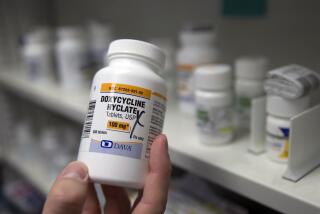Local Researchers Warn of ‘Rogue Condoms’ Availability
- Share via
Officials of a joint UCLA-USC condom-safety research project discovered a batch of what they characterize as “rogue condoms” so prone to failure that researchers intentionally broke the study’s internal secrecy codes to notify the U.S. Food and Drug Administration.
But while the defective condoms were discovered in late November and the FDA said the manufacturer said all stocks had been sold out, researchers reported Tuesday they were able to buy some of the condoms in question from at least two Westside drugstores as recently as early this month.
In response, the FDA said Tuesday it was reopening an inquiry into the batch in question.
The discovery was the latest development in the UCLA-USC research, in which experts are attempting to identify prophylactics that may reliably prevent transmission of the AIDS virus. The study has evaluated 35 U.S. and foreign-made brands, and researchers are now concentrating on 10 of those for additional study.
Can’t Be Certain
An FDA official, speaking on the condition he not be identified, said he could not be certain whether the federal agency’s own condom-testing program--ordered last March in response to growing questions about the safety of condoms used to try to prevent the spread of AIDS--had evaluated the batch in question. The official said it was “unlikely” the batch had been tested by federal agents.
The FDA said it had issued a recall notice for a batch of an identical condom product in December because the lot failed to meet standard FDA tests for leakage. The agency said it received the report of the extreme breakage problem from UCLA-USC researchers about the same time, but that the distributor issued assurances that condoms identified as defective in Los Angeles had all been sold and no stocks remained to be recalled.
And while the FDA said the problem with the batch of as many as 7,500 condoms, distributed nationwide, appeared to be that the products had deteriorated because they were held too long in wholesale warehouses, researchers here, also speaking on the condition they would not be named, questioned whether age was responsible because the batch had been discovered long before the expiration date of its spermicide coating.
Several attempts by The Times on Tuesday to reach officials of National Sanitary Laboratories, the distributor, at the company’s Chicago headquarters were unsuccessful.
The new questions about the specific batch were raised simultaneous to publication of an article in a medical journal in which a team of North Carolina contraception researchers underscored the quandary faced by public health officials as they grapple with ways to limit AIDS.
While condoms have been placed in a front-line position in the hastily organized campaign to control AIDS, said the researchers at Family Health International in Durham, N.C., reliance on condoms as an AIDS preventative still is nothing more than “common sense substantiated by a small amount of less than conclusive clinical evidence.”
The focus of the urgent notification from the UCLA-USC team, according to the FDA, is a batch of condoms sold under the Protex brand identified on packaging as a type called “Contracept Plus” with an expiration date of Nov. 15, 1990. The FDA said little was known about the batch except that the condoms in question were made in the United States and repackaged by National Sanitary Laboratories for sale.
UCLA-USC researchers said anyone who has purchased condoms of the affected batch should discard them immediately.
Bruce Voeller of Mariposa Foundation, a condom expert involved in the local study, said discovery of the defective batch so concerned officials of the study that they decided to break secrecy codes built into the research--to ensure that scientists are not biased by brand-name affiliation--so the FDA could take immediate enforcement action.
UCLA-USC researchers emphasized that identification of the significantly defective condom batch should not be perceived as a reason to question the safety of condoms in general. “The fact is that this is a rogue condom,” Voeller said, “but condoms, in general, are the major route available for people to protect themselves against AIDS.”
Failures Noted
Voeller said researchers had purchased 1,000 of the condoms as part of the large local study but the Contracept Plus brand was so fragile that some of the condoms broke when they were being removed from their packaging while others were unable to withstand inflated pressures of far less than one pound of air without bursting at the tip.
Such failures in actual use, Voeller said, might expose sexual partners of condom users to potentially catastrophic infection with the AIDS virus or the spread of other sexually-transmitted diseases--as well as render the condoms useless as a means of birth control.
The FDA said it received the warning from the researchers late in November. Coincidentally, the agency had ordered the recall of the identical lot almost simultaenously. Early this month, UCLA-USC researchers said they bought packages of the defective condoms in question in Southern California at two local pharmacies, at least.
Researchers said it was difficult to determine the cause of the major condom batch failure since labeling indicated the products involved were well within their effective date. Voeller said the spermicide was a type called Nonoxynol 9, which researchers have identified as apparently able to impede the spread of human immunodeficiency virus (HIV), the precursor of AIDS. The reason Nonoxynol 9 affords this apparent protection is not yet understood.
Initially Alarmed
Voeller said researchers were initially alarmed that the spermicide itself might have caused the latex rubber in the condoms to break down. But he said that possibility was eventually discounted though researchers still are concerned that other chemicals in the spermicide mixture may have been responsible. Pinpointing the precise nature of the defect, Voeller said, could be a major clue to ways to enhance the safety of condoms in general while making them more specifically effective against HIV transmission.
While additional details of the UCLA-USC study are not scheduled for release until June, at the earliest, it was learned that researchers are now conducting extensive tests on 10 brands of condoms out of the 35 originally selected to be tested. The 10 finalists, officials of the study emphasized, are not necessarily the only effective condoms.
It was unclear when the research team, whose work is being financed by the National Institutes of Health, would publicly identify brands that appear safe and unsafe for use in limiting HIV.
The research is going on as other public health experts continue to explore the precise value of condoms in the fight to control AIDS. In recent months, experts have questioned whether enough is known about the forces exerted on condoms in anal intercourse, in particular, to justify public education campaigns that have appeared to depict condoms as effective against AIDS.
Paul Feldblum, one of two North Carolina researchers involved in the new article in the American Journal of Public Health, said the condom review underscored how little is known about the preventive abilities of prophylactics. Feldblum and researcher Judith Fortney concluded that scientific evidence for reliance on condoms as an AIDS preventive “is not strong,” though such barrier methods originally developed for use in birth control are still the only major weapon available if people at risk of contracting HIV cannot abstain from sex entirely.
“While use of condoms or spermicides is unlikely to be harmful, there is the potential for harm if their use is substituted for abstinence, monogamy or good judgment,” Feldblum and Fortney concluded. They urged priority research to reliably measure the comparative HIV infection rates of condom and spermicide users in terms of the odds they face with each act of intercourse.
They also urged studies to establish the comparative effectiveness of condoms when used in vaginal, anal and oral sex as well as the willingness of high-risk groups to use them unfailingly, in every sexual encounter.
“We certainly are not trying to kick the legs out from under that sort of program,” Feldblum said in a telephone interview Tuesday. “But we would like to see more information available before such (emphatic) recommendations are made. How much protection can be expected? How many cases of AIDS can we prevent (with condoms)? We really can’t answer those questions.”






